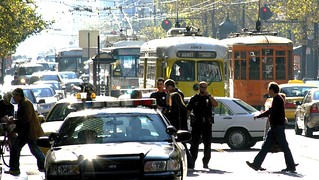New evidence that smart growth may reduce local congestion as well as overall driving

Posted June 8, 2012 at 1:23PM
We have long known that residents of smart-growth neighborhoods – those with central locations, walkable streets, nonsprawling densities, and a good mix of shops and amenities – drive significantly less than do residents of spread-out suburban subdivisions. But, writing in his blog hosted by Planetizen, Todd Litman reports on a new Arizona study that found that those attributes can reduce local congestion as well:
“[The study] found that roadways in more compact, mixed, multi-modal communities tend to be less congested. This results from the lower vehicle trip generation, particularly for local errands, more walking and public transit travel, and because the more connected street networks offer more route options so traffic is less concentrated on a few urban arterials. This contradicts our earlier assumptions.”
This is a little counterintuitive, since many of us have had the experience of finding roadway traffic to be more congested as we drive from a less dense neighborhood to or through one with a greater concentration of development and uses.  To some extent, this appears to be because of the presence of more stoplights and other traffic controls in higher-density areas in order to regulate vehicle traffic arriving at an intersection from multiple directions, and sometimes because of controls designed to increase safety for pedestrians. It is possible that, while drivers are experiencing substantially longer travel times through denser areas, it is due to the controls and not necessarily because traffic volume is higher.
To some extent, this appears to be because of the presence of more stoplights and other traffic controls in higher-density areas in order to regulate vehicle traffic arriving at an intersection from multiple directions, and sometimes because of controls designed to increase safety for pedestrians. It is possible that, while drivers are experiencing substantially longer travel times through denser areas, it is due to the controls and not necessarily because traffic volume is higher.
I would like to see more research to tease out the precise factors that can make smart growth reduce congestion, because I don’t think it always does. The more we can learn about this, the more we can refine our understanding of how to make good, walkable development even better. The study, published by the Arizona Department of Transportation, certainly gives one hope. Read Todd’s full analysis here.
Related posts:
- Traffic explained, then fixed in 4 entertaining minutes (April 17, 2012)
- New data show how transit corridors reduce traffic, increase walking (August 17, 2011)
- Estimating the impacts of smart growth: the importance of forecasting traffic correctly (July 1, 2010)
- The definitive study of how land use affects travel behavior (June 4, 2010)
- Important new research confirms that development near transit substantially reduces driving (August 26, 2008)
Move your cursor over the images for credit information.
Please also visit NRDC’s Sustainable Communities Video Channel.
